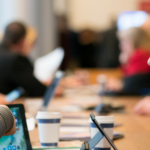Sharing Engagement Successes
Shorter sessions, more breaks and chat games were just some of the virtual audience engagement successes Tracy Lake, CMP, shared with the Gulf States viewers at the chapter’s first roundtable of the year last week.
Lake, Director of Events for FastSigns, is a veteran meeting planner and is known for her creative and innovative ideas which she eagerly detailed from the discovery and planning stages all the way through the wrap up of her first on‐line conference.
“It was so scary,” said Lake of her July 2020 meeting. “I didn’t know what I was doing. No one else did either.”
So, when you don’t know, you start at the beginning. Lake spent the early spring months researching virtual platforms, attending as many virtual conferences as she could and talking to her peers to piece together the ‘likes’ and ‘dislikes’ of what she was seeing.
Rather than trying to recreate her live event on to a platform, she re‐shaped her program to fit what the platform could produce. Lake and her team identified three key words to define their program goals, Connection, Education and Inspiration.
From attending other virtual events, she knew time and content were going to have to change. Attention spans on line were much shorter than in person.
“The hour and half keynote is dead,” she said. “The hour keynote is dead, the 45‐minute keynote is dead. Thirty minutes is about all an audience is going to sit through.”
Paring down speaker presentations and/or splitting them into multiple presentations and sprinkling that content throughout the event kept attendees from the hour‐plus long sessions that they probably wouldn’t sit through.
Controlling these presentations through pre‐recordings and limiting the number of “live” events allowed the conference to move at a better pace with little to no glitches. “Pre‐record as much as you can,” stressed Lake who took FastSigns’ three‐day event and made it four days in order to accommodate shorter meeting times per day, “and come up with ways to make it look live.”
In Lake’s sessions that were pre‐recorded, but had live Q&A following the presentation, she required the speakers to wear the same clothes that they did the recording in to keep the look‐live feel. She worked pre‐event with each speaker to make sure the speaker’s technology (laptop, lighting, audio, etc.), origin room and overall look was appropriate.
For her General Sessions she had an emcee to move the session along.
Although many of the emcee’s interactions were recorded, he would come on live during specific times between presentations (wearing the same clothes as he was recorded in) and would engage with the audience through chat games and challenges keeping the audience engaged.
“It soooo important to have an emcee. You want an emcee,” Lake stressed. “You want an emcee to welcome everybody. Kind of get it going…get it fun. They introduce the speaker. (On the recording) we would have speakers enter and exit from one side of the stage and the emcee would enter from the other. The audience couldn’t tell what was live and what wasn’t.”
When planning your virtual meeting, it’s easy for planners to see all the elements you can’t offer compared to a live meeting, but Lake took the other side of that observation and asked, “What can we do now that we couldn’t do before?”
Having speakers answer all of the attendee questions was doable in a virtual setting. In a live event, a speaker might be able to take six or seven questions at the end of their talk and that’s it. With an open chat environment or live Q&A sessions, Lake and her team encouraged attendees to ask as many questions through the chat or Q&A platform.
Her team saved all the questions and had speakers answer all the questions during or following the event so every attendee that had a question received an answer. This opportunity kept the audience engaged and extended the attendee engagement even after the meeting.
Breaks were another important focus. Utilizing countdown clocks, music and motion video/graphics (i.e. commercials, trivia, polls, etc.) before a session begins let the attendees know when the session was about to start while already engaging them in the meeting.
“Even in between sessions. Shorter sessions, five minutes in between, so you can go check an e‐mail, go to the bathroom, take care of a pet, whatever you need to do,” she continued. “You never click out. You see the clock on the screen so you know when the next session starts.”
In addition, Lake went into detail about the success her conference had with vendors as well as how her team designed ways to recognize awardees throughout the meeting and how attendees were able to network with each other daily.
During her presentation, Lake took questions from Gulf States members about her conference’s different engagement tools. Here is a list of Lake’s successes for an engaging virtual meeting:
1. Shorter programs
2. Q & A for everyone
3. Chat games and challenges
4. Emcee for a live event
5. Pre‐record as much as possible for control
6. Work on the continuity
7. Have music, motion and clock during the breaks
8. Take frequent breaks
9. Updated vendor show*
10. Kickoff event*
*To get more details on these items and to watch the complete roundtable click here.
Register now for the next Gulf States Chapter Roundtable on February 25th!



